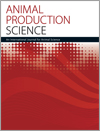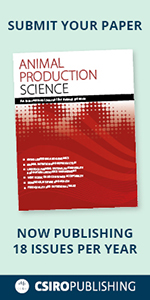
Animal Production Science
Volume 62 Number 3 2022
AN21118Fleece rot in sheep: a review of pathogenesis, aetiology, resistance and vaccines
Following wetting for several days or more, bacteria proliferate on the skin and in the wool to cause fleece rot which predisposes sheep to fly strike. This review examines the bacteria associated with fleece rot, their role in the disease, sheep factors influencing susceptibility to infection, defences of the sheep against infection and past efforts to develop vaccines. This background sets the scene for an accompanying review on new opportunities for vaccine development.
AN21118 Abstract | AN21118 Full Text | AN21118PDF (621 KB) Open Access Article
The Gyr breed has been selected in Brazil for 40 years, mainly for total milk yield. The lactation persistency is closely related to the profitability of a milk production system. More persistent cows need less inputs, they get less sick, have more stayability and behave better reproductively. The results indicated that it is possible to make a selection for lactation persistency and that the second measure considered is better suited to the behavior of milk yield in Gyr breed.
AN20041Estimates of genetic parameters, principal components and cluster analysis for milk yield and body weight in Guzera cattle
 , Henrique Torres Ventura, Mariana Alencar Pereira, Luara Afonso Freitas, Claudia Cristina Paro Paz and Lenira El Faro
, Henrique Torres Ventura, Mariana Alencar Pereira, Luara Afonso Freitas, Claudia Cristina Paro Paz and Lenira El Faro
The Guzera breed is in second position among Zebu breeds for milk production and is also used as a dual-purpose breed in some Brazilian production systems. The genetic correlations suggest that selection to increase milk yield will lead to selection in the same direction for body weight at different ages. The Guzera breed has the genetic potential to meet different selection objectives, either beef or milk production, or to produce dual-purpose animals as indicated by principal component analysis and cluster analysis.
The broilers are prone to immunological stress under unsuitable environmental conditions, the low immunity resulting in inflammatory bowel diseases. This study reveals a protective mechanism of Artemisia argyi alcohol extract as a potent antioxidant and demonstrates that AAAE can be efficiently applied in poultry and animal production to promote health.
Conjugated linoleic acid (CLA) is very important for animals and humans. CLA requirement for deer have not been established. Our objective was to evaluate the effects of dietary CLA supplementation on growth performance, nutrient digestibility and blood biochemical parameters and nutrient digestibility in sika deer.
AN21026 Abstract | AN21026 Full Text | AN21026PDF (244 KB) Open Access Article
Nano forms of selenium have greater bioavailability and lower biotoxicity than inorganic forms, but an enormous concern about the application of the chemical form of nano-selenium may inhibit extensive use. Chemical synthesis of nano minerals can have harmful environmental and animal consequences. Green nanotechnology is an environmentally sustainable, safe, biocompatible and cost-effective approach. The present experiment was conducted to evaluate the effects of green synthesised nano-selenium on performance of broiler chickens.
AN21136Energy sources in diets for lambs in confinement
 , Mara L. A. Pereira
, Mara L. A. Pereira  , Herymá G. de O. Silva, Alana B. dos Santos, Leandro S. O. Ribeiro, Douglas dos S. Pina, Leandro B. Sousa and Gleidson G. P. de Carvalho
, Herymá G. de O. Silva, Alana B. dos Santos, Leandro S. O. Ribeiro, Douglas dos S. Pina, Leandro B. Sousa and Gleidson G. P. de Carvalho 
The raising of sheep is performed mostly exclusively on pasture; however, these rearing systems are subject to irregular availability of forage, and, consequently, reduction of the herd, and irregular supply of meat products. Thus, in an attempt to resolve this, it is necessary to adopt nutritional tools that are able to shorten the production cycle. Wheat bran, sorghum and mesquite pod meal can completely replace maize in the concentrate in the diets for feedlot lambs.
AN21250Characterisation of productive performance, body reserve dynamics and energy metabolic parameters of Holstein Friesian and Normande dairy cows managed in a low-input pastoral dairy system
 , Laura Astigarraga, Cecilia Loza, Mariana Carriquiry, Daniel E. Rico and Andrea Álvarez-Oxiley
, Laura Astigarraga, Cecilia Loza, Mariana Carriquiry, Daniel E. Rico and Andrea Álvarez-Oxiley
The demand for dairy products from low-input pastoral systems is increasing. However, in autumn and winter, cows lose body condition due to low pasture availability and harsh weather. We compared Normande versus Holstein Friesian cows’ performance to determine the suitability of these breeds to these conditions. Normande cows had a shorter period of body reserves mobilisation and a greater recovery of insulin sensitivity during early lactation. Compared with Holstein Friesian cows, Normande cows can avoid large body reserves mobilisation, likely because of their lower milk yield potential.
AN20630Validation of hand-held refractometers for assessing Merino ewe colostrum and neonatal lamb serum
 , Nada Blagojevic, Nicholas J. Murdock, Holly B. Mills, Tom Flinn, Niki L. McCarthy
, Nada Blagojevic, Nicholas J. Murdock, Holly B. Mills, Tom Flinn, Niki L. McCarthy  , Jennifer M. Kelly, David O. Kleemann
, Jennifer M. Kelly, David O. Kleemann  and William H. E. J. van Wettere
and William H. E. J. van Wettere
The rapid assessment of colostrum in Merino ewes would provide valuable information regarding estimated immunoglobulin G (IgG) transfer and survival potential of lambs. Our research demonstrated that compared with laboratory tests, a hand-held refractometer was a crude measure of colostrum quality in ewes, and provided valuable information regarding estimated IgG transfer and lamb survival potential to 72 h. The use of a refractometer would be a cost-effective, easy-to-use tool for on-farm research or intensively managed flocks.
AN20370Validation of body condition score based on subcutaneous fat thickness measurements in primiparous Gyr cows
 , Ana Carolina Almeida Rollo de Paz, Ricardo Dutra do Bem, Glayk Humberto Vilela Barbosa, Maria Eugênia Zerlotti Mercadante, Aníbal Eugênio Vercesi Filho, André Rabelo Fernandes and Lenira El Faro
, Ana Carolina Almeida Rollo de Paz, Ricardo Dutra do Bem, Glayk Humberto Vilela Barbosa, Maria Eugênia Zerlotti Mercadante, Aníbal Eugênio Vercesi Filho, André Rabelo Fernandes and Lenira El Faro
This study is very important because it is a study that evaluated and validated the body condition score of primiparous zebu cows with weight and fat thickness measurements by carcass ultrasonography, using several measures cited in the literature. It is a methodology accessible to the producer, requires technical training but at a low cost in relation to the ultrasound of the carcass. There are not many studies such as this for this category and animal breed, having thus great scientific importance.



